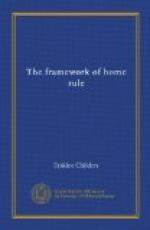is still very bad.[59] Many of the school-houses are,
in the words of the Commissioners, “mere hovels,”
unsanitary, leaky, ill-ventilated. The distribution
of schools and funds is chaotic and wasteful.
Out of 8,401 schools (in 1909-10)[60] nearly two hundred
have an average daily attendance of less than fifteen
pupils. In 1730 the number is less than thirty,
and it is not only in sparsely inhabited country districts,
but in big towns, that the distribution is bad.
The power of the Commissioners to stop the creation
of unduly small schools, and even semi-bogus establishments
which come into being in the great cities, is imperfect.
Another example of the curious mixture of anarchy and
despotism that the system of Irish government presents
may be seen in the Annual Report of the Commissioners.
With a mutinous audacity which would be laughable,
if the case were one for laughing, the Commissioners
openly rail at the Treasury for the parsimony of its
grants, and, in order to stir its compassion, paint
the condition of Irish education in black colours.
Imagine the various Departmental Ministers in Great
Britain publicly attacking in their Annual Reports
the Cabinet of which they were members! The Treasury,
needless to say, is not to blame. It pays out
of the common Imperial purse all but a negligible fraction
of the cost of primary education in Ireland.
Nothing is raised by rates, and only L141,096 (in
1909-10) from voluntary and local sources, as compared
with L1,688,547 from State grants. The Treasury
has no guarantee that this money is well spent; on
the contrary, it knows from the Reports of the Commissioners
themselves that a great deal of it is very badly spent.
The business is a comic opera, but it has a tragic
significance for Ireland. Primary education is
so bad that a great number of the pupils are absolutely
unfit to receive the expensive and excellent technical
instruction organized by the Department of Agriculture
and Technical Instruction, and contributed to by the
ratepayers. The Belfast Technical Institute, for
example, has to go outside its proper functions, and
spend from its too small stock in providing introductory
courses in elementary subjects, so as to equip children
for the reception of higher knowledge.[61] All over
the country the complaint is the same. No machinery
whatever exists for co-ordinating primary, secondary,
technical, and University education, and opportioning
funds in an economical and profitable manner.
Religion is the immediate cause of the trouble; absence
of popular control the fundamental cause. The
national system of primary education, designed originally
in 1831 to be undenominational, has become rigidly
denominational. Out of 8,401 primary schools,
2,461 only are attended by both Protestants and Roman
Catholics. The rest are of an exclusively sectarian
character. Even the Protestants do not combine.
The Church of Ireland, the Presbyterians, the Methodists,
and other smaller denominations, frequently have small
separate schools in the same parish. The management
(save in the model schools, which are attended only
by Protestants) is exclusively sectarian, the local
clergyman, Roman Catholic, Church of Ireland, or Nonconformist
having almost autocratic control over the school.




